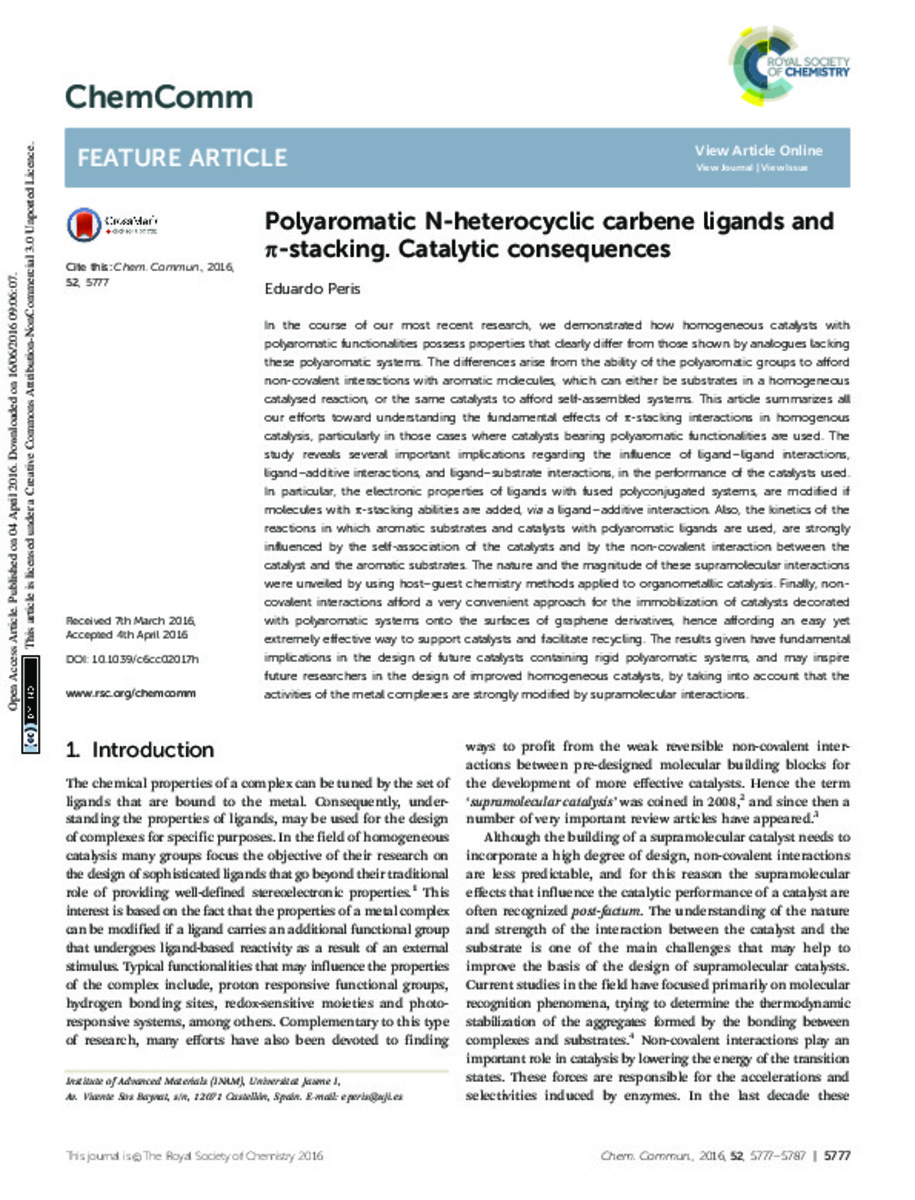Mostrar el registro sencillo del ítem
Polyaromatic N-heterocyclic carbene ligands and π-stacking. Catalytic consequences
| dc.contributor.author | Peris, Eduardo | |
| dc.date.accessioned | 2016-06-20T07:04:36Z | |
| dc.date.available | 2016-06-20T07:04:36Z | |
| dc.date.issued | 2016-04 | |
| dc.identifier.citation | PERIS, Eduardo. Polyaromatic N-heterocyclic carbene ligands and π-stacking. Catalytic consequences. Chemical Communications, 2016, vol. 52, no 34, p. 5777-5787 | ca_CA |
| dc.identifier.issn | 1359-7345 | |
| dc.identifier.uri | http://hdl.handle.net/10234/160889 | |
| dc.description.abstract | In the course of our most recent research, we demonstrated how homogeneous catalysts with polyaromatic functionalities possess properties that clearly differ from those shown by analogues lacking these polyaromatic systems. The differences arise from the ability of the polyaromatic groups to afford non-covalent interactions with aromatic molecules, which can either be substrates in a homogeneous catalysed reaction, or the same catalysts to afford self-assembled systems. This article summarizes all our efforts toward understanding the fundamental effects of p-stacking interactions in homogenous catalysis, particularly in those cases where catalysts bearing polyaromatic functionalities are used. The study reveals several important implications regarding the influence of ligand–ligand interactions, ligand–additive interactions, and ligand–substrate interactions, in the performance of the catalysts used. In particular, the electronic properties of ligands with fused polyconjugated systems, are modified if molecules with p-stacking abilities are added, via a ligand–additive interaction. Also, the kinetics of the reactions in which aromatic substrates and catalysts with polyaromatic ligands are used, are strongly influenced by the self-association of the catalysts and by the non-covalent interaction between the catalyst and the aromatic substrates. The nature and the magnitude of these supramolecular interactions were unveiled by using host–guest chemistry methods applied to organometallic catalysis. Finally, noncovalent interactions afford a very convenient approach for the immobilization of catalysts decorated with polyaromatic systems onto the surfaces of graphene derivatives, hence affording an easy yet extremely effective way to support catalysts and facilitate recycling. The results given have fundamental implications in the design of future catalysts containing rigid polyaromatic systems, and may inspire future researchers in the design of improved homogeneous catalysts, by taking into account that the activities of the metal complexes are strongly modified by supramolecular interactions. | ca_CA |
| dc.description.sponsorShip | Financial support from the ‘Ministerio de Economía y Competitividad’ MINECO of Spain (CTQ2014-51999-P) and the Universitat Jaume I (P11B2014-02) | ca_CA |
| dc.format.extent | 11 p. | ca_CA |
| dc.format.mimetype | application/pdf | ca_CA |
| dc.language.iso | eng | ca_CA |
| dc.publisher | Royal Society of Chemistry | ca_CA |
| dc.relation.isPartOf | Chemical Communications, 2016, 52, p. 5777-5787 | ca_CA |
| dc.rights | This journal is © The Royal Society of Chemistry 2016 | ca_CA |
| dc.rights | Attribution-NonCommercial 4.0 Spain | * |
| dc.rights.uri | http://creativecommons.org/licenses/by-nc/4.0/ | * |
| dc.title | Polyaromatic N-heterocyclic carbene ligands and π-stacking. Catalytic consequences | ca_CA |
| dc.type | info:eu-repo/semantics/article | ca_CA |
| dc.identifier.doi | http://dx.doi.org/10.1039/C6CC02017H | |
| dc.rights.accessRights | info:eu-repo/semantics/openAccess | ca_CA |
| dc.relation.publisherVersion | http://pubs.rsc.org/en/Content/ArticleLanding/2016/CC/C6CC02017H#!divAbstract | ca_CA |
| dc.type.version | info:eu-repo/semantics/publishedVersion |
Ficheros en el ítem
Este ítem aparece en la(s) siguiente(s) colección(ones)
-
INAM_Articles [505]








